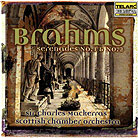May 2000
That he rejected the "modernism" of the music of the later half of the 19th century is curious, but part of his legacy. This is obviously what I think attracts many to his music. He didn’t dwell in the past -- he quickly developed his own style, yet he didn’t stray too far from the conservative structure of the generation of composers that precedes him. These two serenades are certainly not Brahms’ best-known works. In fact, Serenade No.1 is more "old school" Brahms, reminiscent of his First Symphony. Still, it is a pretty good work and deserves greater popularity. Likewise, Serenade No. 2 will not make many "favorite Brahms" lists, including mine, but is still an excellent piece of music. Some will be familiar with both of these compositions, as they often are tacked on with other of his more popular works. Those readers with a few gray hairs might be familiar with Toscanini’s or Bernstein’s accounts. Nevertheless, a newly recorded CD with both the First and Second serenades is a good idea, and it’s made even better because they are played and conducted so magnificently on this disc. Mackerras has become quite a well-known conductor of Brahms, not in small part to his excellent accounts of all four symphonies released in 1997 [Telarc CD-80450]. Although the serenades use smaller forces, it sounds as if Mackerras put no less effort into making this CD as convincing. Even I am not a huge fan of Brahms, but Mackerras manages to draw me into these works. He accomplishes this in a number of ways. Most significantly, it sounds as if he is leading an ensemble that is as enthusiastic about the works as he is. There is no doubt that they are very well rehearsed and more than accustomed to the maestro’s style of conducting. That the individual members of the Scottish Chamber Orchestra are listed in the booklet is no surprise -- all members sounds as if they are extremely proud of the sounds that emanates from their individual instruments. Yet they sound as if they are on a mission that unifies them -- as conductor, musicians, and composer. As an audiophile, for years I have wondered what the term "transparency" meant when applied not to an audio system but to a musical ensemble, be it an orchestra or a chamber group. I don’t think I would use the term as it relates to audio in reference to any CD or LP because one can find fault with just about any recording. That doesn’t mean that there aren’t exemplary recordings in existence; there are, but the ideally "transparent" recording would be one that sounds as if there is absolutely no recording equipment audible in the recording itself. The deviations in transparency in this particular recording manifest themselves in a slightly harsh sound, one that is surprisingly more harsh than other recent Telarc releases. But this harshness is not by any means severe, and otherwise this is a fine recording. It sounds as if the microphones were placed relatively close to the musicians, and the resulting sound is detailed, but not overly so. This is an excellent recording with only minor flaws. If one would like to hear what the term transparency means as it relates to a performance, this recording is a good example. Any lack of transparency between the composer, the score, and the musicians’ performance is only because original instruments were not used. However, I’m thankful for that -- I’m not a big fan of performances with the old-fashioned instruments. I think if Brahms heard this performance, he would be equally impressed with the accuracy of both the musicians and the instruments that they are playing. He would also likely be impressed with the skill of Sir Charles Mackerras. If you like Brahms’ works, you probably have already acquired this CD. If not, his versions of the symphonies might be a better place to start. However, after you listen to those, it is very likely that you’ll be intrigued by this disc. GO BACK TO: |
 Brahms -
Serenades No. 1 and No. 2
Brahms -
Serenades No. 1 and No. 2![[Reviewed on CD]](../format/regcd.gif) When
most people think of Brahms, they likely picture an elderly, pompous old fogey with a long
gray beard. I observed a photo published in the New York Times about a year ago
that showed a very different Brahms. He was about the age of 25, the age at which he wrote
these two pieces, and he was quite a handsome fellow. If he changed out of his mid-1800s
clothes and into something more contemporary, he could easily pass as a hip, club-going,
Internet-savvy VIP, and he could easily get passed the velvet rope.
When
most people think of Brahms, they likely picture an elderly, pompous old fogey with a long
gray beard. I observed a photo published in the New York Times about a year ago
that showed a very different Brahms. He was about the age of 25, the age at which he wrote
these two pieces, and he was quite a handsome fellow. If he changed out of his mid-1800s
clothes and into something more contemporary, he could easily pass as a hip, club-going,
Internet-savvy VIP, and he could easily get passed the velvet rope.